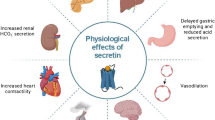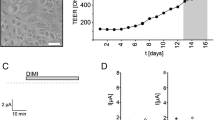Abstract
Guanylin, a bioactive intestinal peptide, is involved in the cystic fibrosis transmembrane conductance (CFTR)-regulated electrolyte/water secretion in various epithelia. In the present work we report on the expression and cellular localization of guanylin and its affiliated signaling and effector proteins, including guanylate cyclase C (Gucy2c), Proteinkinase GII (Pkrg2), CFTR and the solute carrier family 4, anion exchanger, member 2 (Slc4a2) in the hepatobiliary system of rat and guinea pig. Localization studies in the liver and the gallbladder revealed that guanylin is located in the secretory epithelial cells of bile ducts of the liver and of the gallbladder, while Gucy2c, Pkrg2, CFTR, and Slc4a2 are confined exclusively to the apical membrane of the same epithelial cells. Based on these findings, we assume that guanylin is synthesized as an intrinsic peptide in epithelial cells of the hepatobiliary system and released luminally into the hepatic and cystic bile to regulate electrolyte secretion by a paracrine/luminocrine signaling pathway.



Similar content being viewed by others
References
Buccigrossi V, Armellino C, Ruberto E, Barone MV, Marco GD, Esposito C, Guarino A (2011) Polar effects on ion transport and cell proliferation induced by gc-c ligands in intestinal epithelial cells. Pediatr Res 69(1):17–22
Cetin Y, Bargsten G, Grube D (1992) Mutual relationships between chromogranins A and B and gastrin in individual gastrin cells. Proc NatI Acad Sci USA 89:2912–2916
Cetin Y, Aunis D, Bader MF, Galindo E, Jörns A, Bargsten G, Grube D (1993) Chromostatin, a chromogranin A-derived bioactive peptide, is present in human pancreatic insulin (beta) cells. Proc NatI Acad Sci USA 90:2360–2364
Cetin Y, Kuhn M, Kulaksiz H, Adermann K, Bargsten G, Grube D, Forssmann WG (1994) Enterchromaffin cells of the digestive system: celluluar source of guanylin, a guanylate cyclase-activating peptide. Proc NatI Acad Sci USA 91:2935–2939
Cetin Y, Kulaksiz H, Redecker P, Bargsten G, Adermann K, Grube D, Forssmann WG (1995) Bronchiolar nonciliated secretory (Clara) cells: source of guanylin in the mammalian lung. Proc NatI Acad Sci USA 92:5929–59925
Cuthbert AW, Hickman ME, MacVinish LJ, Evans MJ, Colledge WH, Ratcliff R, Seale PW, Humphrey PPA (1994) Chloride secretion in response to guanylin in colonic epithelia from normal and transgenic cysic fibrosis mice. Br J Pharmacol 122:31–36
Dodgson SJ, Foster RE 2nd (1986) Carbonic anhydrase: inhibition results in decreased urea production by hepatocytes. J Appl Physiol 60:646–652
Fonteles MC, do Nascimento NR (2011) Guanylin peptide family: history, interactions with ANP, and new pharmacological perspectives. Can J Physiol Pharmacol 89(8):575–585
Forte LR, Eber SL, Turner JT, Freeman RH, Fok KF, Currie MG (1993) Guanylin stimulation of Cl–secretion in human intestinal T84 cells via cyclic guanosine monophosphate. J Clin Invest 91:2423–2428
Fuller CM, Benos DJ (1992) CFTR! Am J Physiol 263:C267–C286
Garbers DL (1992) Guanylyl cyclase receptors and their endocrine, paracrine, and autocrine ligands. Cell 71:1–4
Garcia-Marin JJ, Peez-Barriocanal F, Garcia A, Serrano MA, Requeiro P, Esteller A (1988) Evidence for the presence of carbonic anhydrase in the plasma membrane of the rat hepatocytes. Biochim Biophys Acta 945:2–17
Guba M, Kuhn M, Forssmann WG, Classen M, Gregor M, Seidler U (1996) Guanylin strongly stimulates rat duodenal HCO3 − secretion: proposed mechanism and comparison with other secretagogues. Gastroenterology 111:1558–1568
Hamra FK, Forte LR, Eber SL, Pidhorodeckyj NV, Krause WJ, Freeman RH, Chin DT, Tompkins JA, Fok KF, Smith CE et al (1993) Uroguanylin: structure and activity of a second endogenous peptide that stimulates intestinal guanylate cyclase. Proc NatI Acad Sci USA 90:10464–10468
Hamra FK, Krause WJ, Eber SL, Freeman RH, Smith CE, Currie MG, Forte LR (1996) Opossum colonic mucosa contains uroguanylin and guanylin peptides. Am J Physio 270:G708–G716
Hamra FK, Eber SL, Chin DT, Currie MG, Forte LR (1997) Regulation of intestinal uroguanylin/guanylin receptor-mediated responses by mucosal acidity. Proc NatI Acad Sci USA 94:2705–2710
Joo NS, London RM, Kim HD, Forte LR, Clarke LL (1998) Regulation of intestinal Cl− and HCO3 − secretion by uroguanylin. Am J Physiol 274:G633–G644
Kulaksiz H, Cetin Y (2001) Uroguanylin and guanylate cyclase C in the human pancreas: expression and mutuality of ligand/receptor localization as indicators of intercellular paracrine signaling pathways. J Endocrinol 170:267–275
Kulaksiz H, Rausch U, Vaccaro R, Renda TG, Cetin Y (2001a) Guanylin and uroguanylin in the parotid and submandibular glands: potential intrinsic regulators of electrolyte secretion in salivary glands. Histochem Cell Biol 115:527–533
Kulaksiz H, Schmid A, Hönscheid M, Eissele R, Klempnauer J, Cetin Y (2001b) Guanylin in the human pancreas: a novel luminocrine regulatory pathway of electrolyte secretion via cGMP and CFTR in the ductal system. Histochem Cell Biol 115:131–145
Kulaksiz H, Rehberg E, Stremmel W, Cetin Y (2002a) Guanylin and functional coupling proteins in the human salivary glands and gland tumors. Am J Pathol 161:655–664
Kulaksiz H, Schmid A, Hönscheid M, Ramaswamy A, Cetin Y (2002b) Clara cell impact in air-side activation of CFTR in small pulmonary airways. Proc NatI Acad Sci USA 99:6796–6801
Kulaksiz H, Schlenker T, Rost D, Stiehl A, Volkmann M, Lehnert T, Cetin Y, Stremmel W (2004) Guanylin regulates chloride secretion in the human gallbladder via the bile fluid. Gastroenterology 126:732–740
Lee MG, Choi JY, Luo X, Strickland E, Thomas PJ, Muallem S (1999a) Cystic fibrosis transmembrane conductance regulator regulates luminal Cl-/HCO3–exchange in mouse submandibular and pancreatic ducts. J Biol Chem 274:14670–14677
Lee MG, WIgley WC, Zeng W, Noel LE, Marino CR, Thomas PJ, Muallem S (1999b) Regulation of Cl-/HCO3–exchange by cystic fibrosis transmembrane conductance regulator expressed in NIH 3T3 and HEK 293 cells. J Biol Chem 274:3414–3421
Lewis LG, Witte DP, Laney DW, Currie MG, Cohen MB (1993) Guanylin mRNA is expressed in villous enterocytes of the rat small intestine and superficial epithelia of the rat colon. Biochem Biophys Res Commun 196:553–560
Li Z, Taylor-Blake B, Light AR, Goy MF (1995) Guanylin, an endogenous ligand for C-type guanylate cyclase is produced by goblet cells in the rat intestine. Gastroenterology 109:1863–1875
Lipsen B, Effros RM (1988) CO2 and bicarbonate exchange in the rat liver. J Appl Physiol 65:2736–2743
London RM, Krause WJ, Fan X, Eber SL, Forte LR (1997) Signal transduction pathways via guanylin and uroguanylin in stomach and intestine. Am J Physiol 273:G93–G105
Miyazato M, Nakazato M, Matsukura S, Kangawa K, Matsuo H (1996) Uroguanylin gene expression in the alimentary tract and extra-gastrointestinal tissues. FEBS Lett 398:170–174
Parkkila S, Parkkila AK, Juvonen T, Waheed A, Sly WS, Saarnio J, Kaunisto K, Kellokumpu S, Rajaniemi H (1996) Membrane-bound carbonic anhydrase IV is expressed in the luminal plasma membrane of the human gallbladder epithelium. Hepatology 24:1104–1108
Pfeiffer A, Aszodi A, Seidler U, Ruth P, Hofmann F, Fässler R (1996) Intestinal secretory defects and dwarfism in mice lacking cGMP-dependent protein kinase II. Science 274:2082–2086
Quinton PM (1999) Physiological basis of cystic fibrosis: a historical perspective. Physiol Rev 79:S3–S22
St. Pierre MV, Schlenker T, Dufour JF, Jefferson DM, Fitz JG, Arias IM (1998) Stimulation of cyclic guanosine monophosphate production by natriuretic peptide in human biliary cells. Gastroenterology 114:782–790
Sterling D, Reithmeier RA, Casey JR (2001) Carbonic anhydrase: in the driver’s seat for bicarbonate transport. JOP 2:165–170
Vaandrager AB (2002) Structure and function of the heat-stable enterotoxin receptor/guanylyl cyclase C. Mol Cell Biochem 230:73–83
Vaandrager AB, Smolenski A, Tilly BC, Houtsmuller AB, Ehlert EME, Bot AGM, Edixhoven M, Boomaars WEM, Lohmann SM, de Jonge HR (1998) Membrane targeting of cGMP-dependent protein kinase is required for cystic fibrosis transmembrane conductance regulator Cl− channel activation. Proc NatI Acad Sci USA 95:1466–1471
Vaccaro R, Cetin Y, Renda TG (2004) Ontogeny of guanylin-immunoreactive cells in rat salivary glands. Anat Embryol (Berl) 208:65–73
Wilhelm B, Keppler C, Hoffbauer G, Lottspeich F, Linder D, Meinhardt A, Aumüller G, Seitz J (1998) Cytoplasmic carbonic anhydrase II of rat coagulating gland is secreted via the apocrine export mode. J Histochem Cytochem 46:505–511
Acknowledgments
We thank for the experimental help of M. Meier during her doctoral thesis in the department. The technical assistance of C. Merte-Grebe and T. Seitz is greatly acknowledged.
Author information
Authors and Affiliations
Corresponding author
Rights and permissions
About this article
Cite this article
Schwabe, K., Cetin, Y. Guanylin and functional coupling proteins in the hepatobiliary system of rat and guinea pig. Histochem Cell Biol 137, 589–597 (2012). https://doi.org/10.1007/s00418-012-0927-2
Accepted:
Published:
Issue Date:
DOI: https://doi.org/10.1007/s00418-012-0927-2




